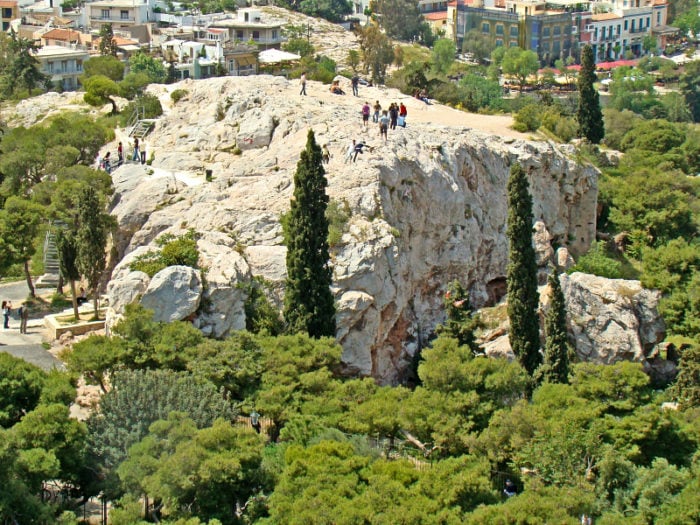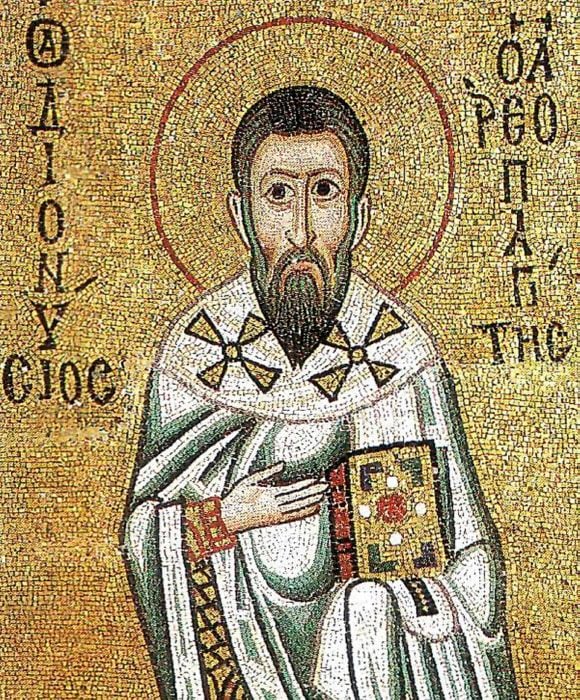
Saint Dionysius the Areopagite, the patron saint of the city of Athens, is also known as the protector of judges and the judiciary. The Greek Orthodox Church celebrates the Feast Day of Saint Dionysius on October 3rd.
Born during the first century AD, Dionysius grew up in a wealthy Athenian family. Before his conversion to Christianity, he was known to have studied extensively, both in Greece and abroad.
According to written sources, Dionysius was married, and he and his wife and had several children.
His broad knowledge and the great success he had in his studies gave him the opportunity to join ancient Greece’s most prestigious court of law, that of the Areopagus.

At the time of Jesus’ crucifixion, Dionysius was in Egypt in a town called Heliopolis (the City of the Sun) near today’s capital of Cairo.
According to Christian tradition, that Good Friday, the very day Jesus Christ died, ”darkness came over all the land.”
Dionysius noticed that day that the sun had disappeared, and he wrote down the exact hour that this peculiar phenomenon had taken place.
Tradition says that Dionysius was so amazed and disturbed by the disappearance of the sun that he uttered the words ”God suffers, or everything is lost.”
His conversion to Christianity

However, for years after this phenomenon, Dionysius didn’t know for sure what the sudden eclipse meant, and whether or not it was actually a sign from heaven.
But years later, he heard a man named Paul preaching on Athens’ Areopagus Hill, next to the Acropolis and close to where his court was located.

Dionysius heard St. Paul explaining that when Jesus died, the daylight completely disappeared and darkness embraced the world. This immediately reminded him of the peculiar phenomenon he had noticed and recorded in Egypt, several years prior.
Convinced that Paul was telling the truth and that his teaching was that of the true faith, Dionysius decided to become baptized in 54 AD.
Dionysius was so passionate about Christ and His revolutionary message that he eventually abandoned his family and judicial career and dedicated himself completely to God.
When the former judge learned that the mother of Jesus was still alive and living in Jerusalem, he decided to visit her there.
Dionysius indeed met Mary there in the Holy Land, and enjoyed many discussions with her. He was also there when she finally passed away, a witness to her Dormition.
The former Greek judge even attended her funeral.
Years later, Dionysius wrote a book in which he explained his belief that the woman he had met and spoken with had indeed been the Mother of God, something that he believed was certain only by the way she had appeared.
In the meantime, Saint Paul had named Dionysius the first Bishop of Athens, which in effect boldly established Christianity as an entity in the very center of the pagan world’s idolatry.
The courageous martyrdom of Dionysius the Areopagite
When Dionysius learned the news that Saint Paul had been executed by beheading outside Rome, he wholeheartedly desired to sacrifice his own life to honor Jesus.
Along with his friends Eleutherius and Rusticus, Dionysius made the courageous decision to go and preach Jesus’ Gospel openly in public.
After managing to convert many pagans to Christianity, Dionysius, the former judge, along with Eleutherius and Rusticus, was in the end beheaded during the reign of Emperor Domitian, in 96 AD.
Some believe that the Greek St. Dionysius actually died in Paris, but in all likelihood that was another martyr, from Gaul, who had the same name, and each St. Dionysius is commemorated on the day of their martyrdom.
The Veneration of St. Dionysius

Saint Dionysius the Areopagite is venerated by both the Orthodox and the Catholic Christian Churches.
The Orthodox Church honors his memory on October 3 every year, while the Catholic Church does so on October 9.
Additionally, the Greek Orthodox Church also celebrates his memory on October 12, the day when all the Athenian saints are celebrated together.
The Catholic Cathedral of Athens is dedicated to Saint Dionysius the Areopagite and an Orthodox church dedicated to his memory also still stands in Kolonaki, downtown Athens.
The construction of the Catholic shrine began in the mid 1840s and it was consecrated in 1853. The Orthodox church dedicated to the saint was consecrated 78 years later, in 1931, after eight years of construction.
Before that, a smaller and more humble church, also dedicated to the same saint, stood at the exact spot where the new temple stands. It was originally built at approximately the same time as the Catholic cathedral of St. Dionysius.
See all the latest news from Greece and the world at Greekreporter.com. Contact our newsroom to report an update or send your story, photos and videos. Follow GR on Google News and subscribe here to our daily email!



